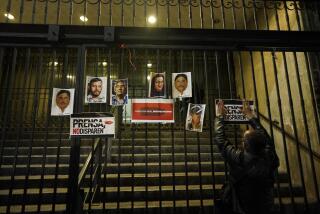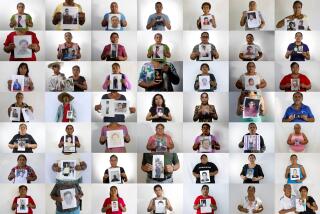Mexican police find a mass grave near the capital

MEXICO CITY — Mexican authorities exhumed at least seven bodies from a clandestine mass grave Thursday and were conducting tests to determine whether they were part of a group of young people kidnapped nearly three months ago from a bar in the heart of this capital.
The city’s top prosecutor, Rodolfo Rios, said that DNA tests would be used to attempt to identify the corpses, which he said were badly decomposed, and that it would take at least 48 hours. By midday, seven bodies had been recovered from the muddy pit, 25 miles east of downtown Mexico City, and the search continued for more under a heavy police guard.
Federal officials, however, downplayed any connection to the 12 people who disappeared from the bar, saying the remains could be older than three months.
Rios said the recovery operation was slow because of the difficulty of the terrain. The remains were found in a hilly wooded area near the town of Tlalmanalco on a farm that grows and sells Christmas trees.
“Given the conditions, it is not yet possible to determine the identities,” Rios said in a hastily called news conference. Earlier, he briefed the families of the 12 who went missing May 26. Some of the family members rushed to the grave site.
The missing people, ages 16 to 34, disappeared en masse after leaving the Heaven after-hours bar in broad daylight on a Sunday in the once-fashionable Zona Rosa district a block from busy Reforma Boulevard, the city’s main thoroughfare, and a short distance from the U.S. Embassy.
Security videos showed the young people getting into cars and being driven away. They were never seen again.
Authorities said they suspected the victims were abducted as part of a battle among rival, small-bit drug dealers. Families insisted their loved ones were not involved in drugs, but all came from the notorious Tepito neighborhood, known for counterfeiting and other criminal enterprise.
The case riveted Mexicans because it challenged the conventional wisdom that this sprawling capital has remained relatively untainted by the kind of vicious violence sweeping much of the country. It has also caused political trouble for Mayor Miguel Angel Mancera, a former top prosecutor who has continued to insist that drug cartels do not operate in the city, even as the search for the 12 victims produced no results.
Ricardo Martinez, a lawyer for some of the families, said he had been alerted to the discovery of the bodies early Thursday and was told there were two graves, one with women and one with men. “I don’t doubt it’s them,” he told Milenio TV.
But Jesus Murillo Karam, the federal attorney general, sought to rein in such speculation, noting that the grave was detected during an unrelated investigation of gun running. He cautioned against jumping to conclusions about the identities and what he called false hope. Other federal officials said the remains might be as old as 6 months.
The owner of the bar and four other people are in police custody; a co-owner evaded arrest but turned up dead — kidnapped outside a movie theater in late June and burned to death along with his girlfriend and her cousin.
Prosecutors have acknowledged that two of the missing are sons of Tepito gang leaders in prison on charges that include homicide or extortion.
Coincidentally, the discovery of the bodies came on the day human rights activists and others were remembering another mass grave uncovered exactly three years ago, that of 72 mostly Central American migrants slain by drug- and people-smuggling gangs working in cahoots with local police.
The massacre in the border state of Tamaulipas, near the village of San Fernando, came to represent the most egregious atrocities in the last seven years of drug-war violence and prompted a flurry of promises about better protection for migrants. But activists said Thursday that those promises have gone unfulfilled, noting that thousands of migrants have disappeared. And many bodies from the San Fernando mass grave as well as other clandestine burial sites remain unidentified.
More to Read
Start your day right
Sign up for Essential California for news, features and recommendations from the L.A. Times and beyond in your inbox six days a week.
You may occasionally receive promotional content from the Los Angeles Times.







